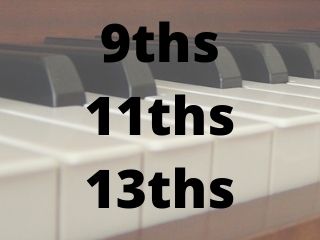The following two tabs change content below.


Greg Lee
Hi, my name is Greg Lee. I'm the creator of the Color Score Professional/Visual Chord Learning System. I love to share ideas and concepts about piano and keyboard playing in all styles of music. I believe the key to learning is having fun and making complicated things simple with visual tools and illustrations.
Latest posts by Greg Lee (see all)
- What is a minor/Major 7 Chord? - October 26, 2023
- 7 Chord Substitutions that Professionals Use - October 19, 2023
- 5 Simple Chord Tricks to Sound Amazing - October 5, 2023


 popular music.
popular music. Even though there only 7 different notes in a key of music, the numbered sequence goes beyond 7. These are called higher extensions.
Even though there only 7 different notes in a key of music, the numbered sequence goes beyond 7. These are called higher extensions. Chords are tertian which is another way to say they're constructed in 3rd intervals (or every 3rd note).
Chords are tertian which is another way to say they're constructed in 3rd intervals (or every 3rd note). It's very common to lower the 7th a half step. This is a flatted 7th tone and creates what is called a dominant 7th chord. Musicians simply refer to it as a 7th chord.
It's very common to lower the 7th a half step. This is a flatted 7th tone and creates what is called a dominant 7th chord. Musicians simply refer to it as a 7th chord. Be aware that the flatted 7th will occur on white keys as well as black keys.
Be aware that the flatted 7th will occur on white keys as well as black keys.



 The differentiating factor of higher extensions is the presence of 1 type of tone that may be present in a chord.
The differentiating factor of higher extensions is the presence of 1 type of tone that may be present in a chord.
 Beyond the 11th tone, you can add the 13th. This can have the 3rd present which makes it a Major chord.
Beyond the 11th tone, you can add the 13th. This can have the 3rd present which makes it a Major chord. Or if the 11th is present, adding the 13th would create a 13th sus chord.
Or if the 11th is present, adding the 13th would create a 13th sus chord.

 Adding the 11th to a Major 7th chord is just as uncommon as adding it to a flatted 7th chord. So the 3rd would be omitted and it would still be a very uncommon chord, especially outside of jazz music.
Adding the 11th to a Major 7th chord is just as uncommon as adding it to a flatted 7th chord. So the 3rd would be omitted and it would still be a very uncommon chord, especially outside of jazz music. Adding the 13th tone to the Major 7th chord creates a Major 13th chord.
Adding the 13th tone to the Major 7th chord creates a Major 13th chord.
